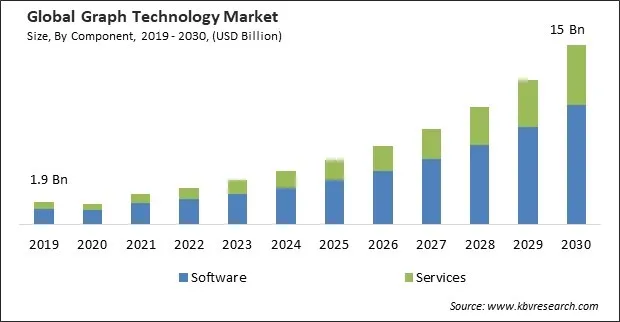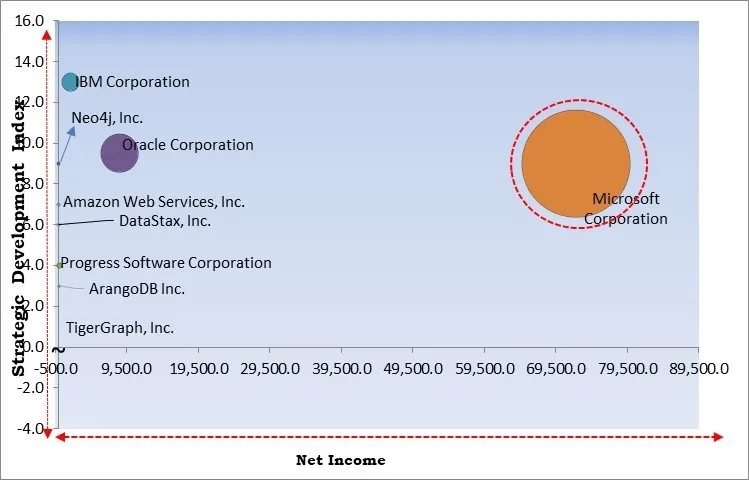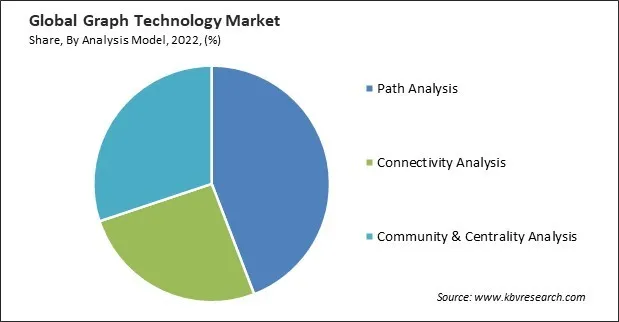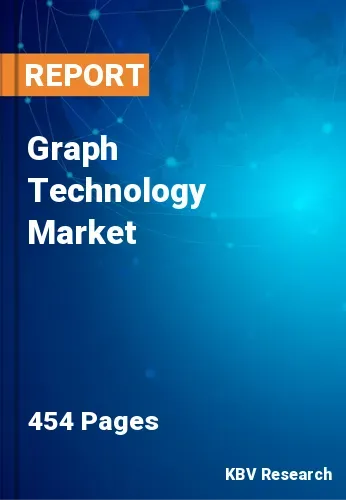The Global Graph Technology Market size is expected to reach $15.0 billion by 2030, rising at a market growth of 22.0% CAGR during the forecast period.
Graph technology plays a vital role in optimizing transportation and infrastructure planning. It aids in modeling transportation networks, analyzing traffic patterns, and planning public transportation routes. Thus, the government and public sector segment captured $209.0 million revenue in the market in 2022. Government agencies responsible for social services and welfare programs leverage graph technology to manage and analyze beneficiary data. By mapping relationships between individuals, families, and their use of public services, agencies can better allocate resources, identify trends, and reduce fraud and inefficiencies. This contributes to more efficient urban planning and infrastructure development.

The major strategies followed by the market participants are Partnerships as the key developmental strategy to keep pace with the changing demands of end users. For instance, In April, 2023, Neo4j, Inc. came into partnership with Imperium Solutions. As a result of the partnership, companies within Singapore would be able to deploy meaningful graph solutions that would help them increase their operational productivity. Moreover, In January, 2023, Neo4j, Inc. signed a partnership with Gemini Data, to develop graph data solutions. The customers would benefit from this partnership by getting the tools to gain quick insights into unseen business opportunities.
Based on the Analysis presented in the KBV Cardinal matrix; Microsoft Corporation is the forerunner in the Market. In December, 2022, Microsoft Corporation partnered with the London Stock Exchange Group (LSEG) to jointly develop new data and analytics products and services. The partnership brings together the combined expertise of two industry leaders that would allow customers to generate business insights and automate complex and time-consuming processes. Companies such as Oracle Corporation, IBM Corporation and Amazon Web Services, Inc. are some of the key innovators in the Market.

Navigating complex and interconnected datasets can be challenging. Graph databases offer efficient and intuitive ways to discover valuable information and patterns within data. This ease of data discovery streamlines operations and enables organizations to uncover insights more quickly, positively impacting their efficiency and productivity. In e-commerce and social networking industries, understanding the relationships and connections between users, products, or content is crucial for delivering a personalized customer experience. It allows businesses to create recommendation systems and user profiling that significantly improve user satisfaction and engagement. Thus, these factors will propel the demand in the market.
Economies of scale come into play as more industries adopt graph technology. This means that the cost of developing, deploying, and maintaining graph-based solutions decreases as technology becomes more widespread. Lower costs encourage even broader adoption as organizations find it cost-effective to implement these solutions. A diverse set of industries adopting graph technology creates a feedback loop of innovation. The technology providers receive insights and requirements from various sectors, which helps them tailor their solutions to meet the specific needs of each industry. This iterative innovation cycle enhances the overall capabilities and usability of graph technology. These factors will help in the future expansion of the market.
Graph databases typically use their query languages, such as Cypher for Neo4j. Learning and mastering these query languages can be time-consuming, especially for those familiar with SQL or other query languages. Integrating graph technology into existing data ecosystems can be complex. Ensuring that data flows seamlessly between graph databases and other data stores may require custom development and middleware solutions. These factors can limit the growth of the market.
Based on deployment, the market is segmented into cloud and on-premise. The on-premise segment held the largest revenue share in the market in 2022. Data security and compliance are given top priority by many firms, particularly in fields with strict regulations like healthcare, finance, and government. On-premise solutions provide greater control over data, making it easier to ensure compliance with industry-specific regulations and protect sensitive information. Data processing and storage are subject to stringent laws in particular areas and sectors. These factors will serve as drivers for the segment’s expansion.
Based on graph type, the market is segmented into property graph, resource description framework (RDF), and hypergraph. In 2022, the hypergraph segment garnered a significant revenue share in the market. Hypergraphs find applications in diverse industries, including social networking, bioinformatics, knowledge graphs, recommendation systems, and supply chain management. Their ability to capture complex relationships, such as multi-modal associations or higher-dimensional data, makes them suitable for various use cases.
On the basis of the analysis model, the market is divided into path analysis, connectivity analysis, and community & centrality analysis. The path analysis segment recorded the maximum revenue share in the market in 2022. Path analysis is integral to recommendation systems. Platforms in e-commerce, content streaming, and online marketplaces leverage path analysis to understand user journeys, identify sequences of actions, and make personalized recommendations. Path analysis remains a critical component as recommendation systems evolve and demand increases.

On the basis of database type, the market is divided into relational (SQL) and non-relational (No SQL). In 2022, the non-relational (No SQL) segment witnessed a substantial revenue share in the market. One of the primary reasons for the growth of non-relational databases in the market is their flexibility in data modeling. Unlike traditional relational databases that require a predefined schema, non-relational databases can handle unstructured, semi-structured, and structured data without rigid constraints. This flexibility is especially beneficial for applications that deal with highly interconnected and dynamic data, which are common in graph-based scenarios. Owing to this, there will be a rise in demand in the segment.
Based on component, the market is segmented into software and services. The software segment held the largest revenue share in the market in 2022. The software component segment has seen growth due to specialized use cases. Organizations are turning to graph databases and analytics for applications like recommendation engines, fraud detection, network analysis, and knowledge graph development. Software providers have tailored their offerings to meet these unique needs. This has driven the adoption of software components that support data integration. These factors will help in the growth of the software segment.
Based on industry, the market is segmented into BFSI, retail & e-commerce, IT & telecom, healthcare & life science, government & public sector, supply chain & logistics, and others. The healthcare and life sciences segment recorded a substantial revenue share in the market in 2022. Graph technology plays a pivotal role in advancing patient-centric care. It allows healthcare providers to create comprehensive patient records encompassing medical history, treatment plans, medication regimens, and social determinants of health. By connecting and analyzing these data points, healthcare professionals can offer more personalized and effective care, leading to better patient outcomes.
On the basis of application, the market is divided into fraud detection, data management & analysis, customer analysis, identity & access management, compliance & risk, and others. The data management and analysis segment recorded the maximum revenue share in the market in 2022. One of the primary drivers of growth in the data management and analysis segment is the exponential growth of data. Graph technology excels at managing and analyzing these data types, making it a compelling choice for businesses seeking insights from their ever-expanding data reservoirs. Therefore, these factors will boost the expansion of this segment.
| Report Attribute | Details |
|---|---|
| Market size value in 2022 | USD 3.1 Billion |
| Market size forecast in 2030 | USD 15 Billion |
| Base Year | 2022 |
| Historical Period | 2019 to 2021 |
| Forecast Period | 2023 to 2030 |
| Revenue Growth Rate | CAGR of 22% from 2023 to 2030 |
| Number of Pages | 454 |
| Number of Table | 754 |
| Report coverage | Market Trends, Revenue Estimation and Forecast, Segmentation Analysis, Regional and Country Breakdown, Competitive Landscape, Companies Strategic Developments, Company Profiling |
| Segments covered | Component, Database Type, Deployment, Graph Type, Analysis Model, Application, Industry, Region |
| Country scope | US, Canada, Mexico, Germany, UK, France, Russia, Spain, Italy, China, Japan, India, South Korea, Singapore, Malaysia, Brazil, Argentina, UAE, Saudi Arabia, South Africa, Nigeria |
| Growth Drivers |
|
| Restraints |
|
By region, the market is segmented into North America, Europe, Asia Pacific, and LAMEA. In 2022, the Europe segment acquired a considerable revenue share in the market. The financial services sector in Europe has witnessed significant adoption of graph technology. Banks and financial institutions use graph databases and analytics to detect fraudulent activities, identify money laundering schemes, and assess credit risk by analyzing intricate transaction networks. Researchers leverage graph technology to analyze complex relationships in genomics and proteomics data. Owing to these factors, the segment is expected to grow rapidly in the future.
Free Valuable Insights: The Global Graph Technology Market size to reach USD 15 Billion by 2030
The market research report covers the analysis of key stake holders of the market. Key companies profiled in the report include Oracle Corporation, IBM Corporation, Neo4j, Inc., Stardog Union, Amazon Web Services, Inc. (Amazon.com, Inc.), Microsoft Corporation, ArangoDB Inc., TigerGraph, Inc., Progress Software Corporation and DataStax, Inc.
By Component
By Database Type
By Deployment
By Graph Type
By Analysis Model
By Industry
By Application
By Geography


This Market size is expected to reach $15.0 billion by 2030.
Exponential growth of data complexity and interconnectedness are driving the Market in coming years, however, Complexity associated with implementing graph technology restraints the growth of the Market.
Oracle Corporation, IBM Corporation, Neo4j, Inc., Stardog Union, Amazon Web Services, Inc. (Amazon.com, Inc.), Microsoft Corporation, ArangoDB Inc., TigerGraph, Inc., Progress Software Corporation and DataStax, Inc.
The expected CAGR of this Market is 22.0% from 2023 to 2030.
The IT & Telecom segment is capturing maximum revenue in the Market by Industry in 2022; thereby, achieving a market value of $3.4 billion by 2030.
The North America region dominated the Market by Region in 2022, and would continue to be a dominant market till 2030; thereby, achieving a market value of $5.1 billion by 2030.
Our team of dedicated experts can provide you with attractive expansion opportunities for your business.

